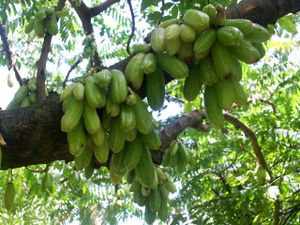Note: This is a project under development. The articles on this wiki are just being initiated and broadly incomplete. You can Help creating new pages.
Difference between revisions of "Averrhoa bilimbi - Belambu"
(→Common names) |
(→Leaf) |
||
| Line 22: | Line 22: | ||
==Identification== | ==Identification== | ||
===Leaf=== | ===Leaf=== | ||
| − | {{Leaf|alternate| | + | {{Leaf|simple|alternate|Green leaves, alternate arrangement and usually clustered at the branch tips, measuring about 30 - 60 cm long, each leaf has about 11 - 37 ovate to oblong leaflets measuring about 2 - 10 cm long and 1.2 cm wide.}}.<ref name="Leaf"/> |
===Flower=== | ===Flower=== | ||
Revision as of 12:19, 13 April 2018
Belambu or Averrhoa bilimbi (commonly known as bilimbi, cucumber tree, or tree sorrel) is a fruit-bearing tree of the genus Averrhoa, family Oxalidaceae. It is a close relative of carambola tree.
Contents
Uses
blood pressure, syphilis, itching, rheumatism, pimples, coughs, {Uses|coughs}}, {Uses|coughs}}.
Parts Used
Chemical Composition
2-furaldehyde; ascorbic acid; butyl-nicotinate; hexyl-nicotinate; niacin; oxalic acid; palmitic acid; riboflavin; thiamine; vitamin A[1]
Common names
| Language | Common name |
|---|---|
| Kannada | Belambu |
| Hindi | Bilimbi |
| Malayalam | Vilumpi |
| Tamil | Pulima |
| Telugu | Gommareku |
| Marathi | NA |
| Gujarathi | NA |
| Punjabi | NA |
| Kashmiri | NA |
| Sanskrit | Belambu |
| English | Bilimbi, Cucumber-Tree |
Habit
Identification
Leaf
| Kind | Shape | Feature |
|---|---|---|
| simple | alternate | Green leaves, alternate arrangement and usually clustered at the branch tips, measuring about 30 - 60 cm long, each leaf has about 11 - 37 ovate to oblong leaflets measuring about 2 - 10 cm long and 1.2 cm wide. |
.[2]
Flower
| Type | Size | Color and composition | Stamen | More information |
|---|---|---|---|---|
| bisexual | 2.5 cm long | bright yellow | 5-20 | The racemes are few-flowered, short, erect, crowded in axils of upper leaves so as to form a large terminal inflorescence stamens barren; the ovary is superior, unilocular, with marginal ovules. |
Fruit
| Type | Size | Mass | Appearance | Seeds | More information |
|---|---|---|---|---|---|
| short legume | 7.5–11 cm long, 1.5 cm broad | clearly grooved lengthwise, Lowest hooked hairs aligned towards crown | oblong, obtuse, tipped with long style base, flat, thin, papery, undulately crimpled, pilose, pale brown. | 12-20 seeds | {{{6}}} |
Other features
List of Ayurvedic medicine in which the herb is used
- Vishatinduka Taila as root juice extract
Where to get the saplings
Mode of Propagation
How to plant/cultivate
A plant of the humid tropical lowlands, where it can also be found at elevations up to 1,200 metres. It grows best in areas where annual daytime temperatures are within the range 23 - 30°c, but can tolerate 10 - 36°c[3]
Commonly seen growing in areas
dLowland primary and secondary forests, along river.
Photo Gallery
References
External Links
- Pages that are stubs
- Ayurvedic Herbs known to be helpful to treat blood pressure
- Ayurvedic Herbs known to be helpful to treat syphilis
- Ayurvedic Herbs known to be helpful to treat itching
- Ayurvedic Herbs known to be helpful to treat rheumatism
- Ayurvedic Herbs known to be helpful to treat pimples
- Ayurvedic Herbs known to be helpful to treat coughs
- Herbs with fruits used in medicine
- Herbs with Leaves used in medicine
- Herbs with common name in Kannada
- Herbs with common name in Hindi
- Herbs with common name in Malayalam
- Herbs with common name in Tamil
- Herbs with common name in Telugu
- Herbs with common name in Sanskrit
- Herbs with common name in English
- Habit - Evergreen Tree
- Index of Plants which can be propagated by Seeds
- Index of Plants which can be propagated by Cuttings
- Herbs that are commonly seen in the region of dLowland primary and secondary forests
- Herbs that are commonly seen in the region of along river
- Herbs




